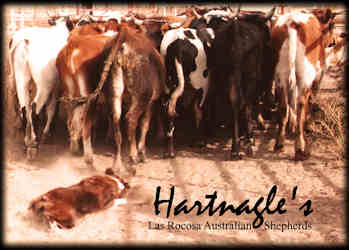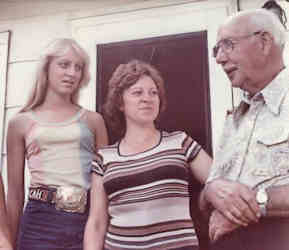 |
||||
|
Education: Books, Videos & Herding Clinics
|
The History of The Australian Shepherd Club of America Chapter V: The Original Purpose of the ASCA Stock Dog Program
To give you an idea of how we were thinking at that time in history I'm going to quote a letter I wrote to Ed Emanuel that was reprinted in the Autumn 1974 National Stock Dog Magazine:
"Dear Ed:
Since I have last written to you and three Stock Dog Trials later, it seems as though the dreams of many stock dog people have reached a reality. Many efforts to accomplish his goals in the past have fallen by the wayside, but the persistence of these same people was not to be taken lightly.
Colorado has had three successful All Breed Trials to date, with plans being laid for two more this year.
The efforts have created an intense enthusiasm and a new following.
Conformation shows for our 'Aussies' are held successfully in many areas of our nation. As of late, we are seeing a definite improvement and uniformity in type. A lot of emphasis on the breed is presently being placed in this area. It is the concern of many dedicated breeders and owners that a very important quality, working instinct, is not being overlooked. Sound conformation is very important, but without the inherited working instinct preserved, the Breed as such would become practically useless.
Sincere breeders must realize this fact and accept the challenge to include performance in their breeding program. To be successful in this area is not an easy task to accomplish or maintain. The working characteristics of each bloodline transmits just as readily and truly as conformation characteristics do.
The newly formed working trial course for Australian Shepherds is proving to be a valuable guide for people to see the various dogs display their own style, intelligence, and degree of working intensity that is relative to their family bloodline. A fairly accurate evaluation can be made by this method, especially when each dog is working the same type of livestock in an identical situation. With this new area of activity now available to Aussie fanciers, I believe that it will enable the Australian Shepherd to maintain its identity as an outstanding stock dog.
Sincerely,
Let me give you some background on the development of the breed during the time previous to my letter at about 1970 to 1973.
To quote Elsie Cotton, early owner, ASCA Vice President (1969 - 1972):
"The Australian Shepherd was first seen in the mid 1800s in California; these medium-sized, unusually powerful dogs were brought in from Australia with flocks of imported sheep. By 1900, they were firmly established on the Colorado and Montana sheep and cattle ranches. They have been verified as being in Oregon as early as 1917.
They maintained their popularity with ranchers due to their unusual agility and working ability; they have a natural herding instinct and it is not at all unusual to see a six week old puppy earnestly endeavoring to 'work' chickens. Combined with this working heritage, is the ability to think for themselves and to boldly guard their families and possessions. The most common colors are Blue merle and Tricolor, but the Red Merles are becoming increasingly popular. AND, in recent years, they are moving from the ranches into the urban and suburban homes as more and more people find them to be the ideal companion dog. Their sensible aggressiveness makes them the ideal guardian and their medium size makes them suitable to keep in homes and to take in the car. Combine all of this with their love for, and patience with, children -- the Aussie cannot help but become increasingly popular."
In 1969, she wrote:
"Some years ago, our Australian Shepherds HAD to work hard, day after day, month in and month out, and had to be sound and 'easy keepers' or they were not kept around. The ones that could do this were the ones that were bred; the others were buried. Any Hip Dysplasia that would have cropped up during this period would show up under this brutally hard work and these unsound dogs would not have been retained on the place, much less bred. There is little room for sentimentality on a large sheep or cattle ranch. Ideally, one should buy an Australian Shepherd from some rancher who is really working his dogs and is demanding consistently hard, continuous work from his breeding stock,"
She went on to write:
"I have a miniature library here; one book is a collector's item and it was printed in 1914, completed with photos and drawings of various top specimens of the various breeds and their Standards. Taking this one book and taking out only 2 or 3 breeds; comparing the 1914 version and the 1971 version in each photo and Standard; well, it is darned easy to see just where each breed went down the drain. Each breed was, at one time, a useful dog. Each breed was shown, and bred, for EXAGGERATION of some, one or two or more extreme qualities. Finally, the old Standard no longer fit the dogs being produced so the Standard was revised by the BREEDERS to fit a less and less useful dog. And so forth, ad nausea.
And THIS can happen to the Australian Shepherd; make no mistake on that and IF it does, we have no one to blame but ourselves.
Right now, we are at the fork in the road. Less and less farm and ranch jobs are available to our Aussies. Due to high taxes on land and high wages for hired hands, more and more types of livestock are being handled in feed lots. One dog (at the most, two) is needed for the handling of stock while sorting for the market, etc. And more and more of the urban and suburban folk are finding the Aussie to be an extremely companionable guard dog. So, the Aussies are, even now, to be found in the cities more than on the farms."
The **For Sale** section of the 1970 - 1972 Aussie Times, contained such phrases as:
At that point in time the Australian Shepherd was known in the fancy as a working stock dog. But, as early as 1970, it was reported that breeders had received letters from potential buyers who insisted on both parents being workers because they had been disappointed with an Australian Shepherd who didn't work. Diane Tuck wrote:
"The working Aussie is what everyone should be breeding for. If we breed strictly for desired coloring and conformation (though conformation is important in working), we'll end up with show dogs like the Poodle or Collie or German Shepherd -- all these dogs were once useful, but look at them now."
She continued to write:
"I know that many people who have Aussies do not live on ranches, but perhaps there could be ways to make working programs available for all Aussies and require that all Aussies pass a working test before being eligible to show in conformation and breeding classes. I know as cattle owners, we tell all our puppy buyers locally that we will be happy to help start their pups working when they are old enough. We offer to do this free of charge."
So far, no one has needed this service. That is because they mostly have their own cattle and the pups work so naturally that they train the people how to work Aussies! I'll bet a cattle pattern could be set up the same as a sheep pattern for show purposes. I'll bet that requirements could be set up for a test for dogs to be eligible to show. Certain honest breeders in each area of the country could be 'inspectors' that would officially pass dogs on working ability. The dogs could be given a certificate proving that they can do what the breed is supposed to do and this certificate should be required at the conformation shows", offered Diane. She concluded by saying "And how proud the owners of the dogs would be to be able to show proof that their dogs were truly Working Australian Shepherds."
In 1970 - 1971, some of the observations and comments made from early owners voicing their concerns pertaining to the future of the Australian Shepherd as a bona fide working stockdog included:
The fanciers at that time wanted a program to preserve the working instinct. Nothing more, nothing less. The program was initially designed to test Aussies, to verify working instinct for ASCA Stock Dog Certification.
It was not originally designed to be a competitive activity program. It was designed to be an evaluation program, documenting the herding characteristics and style of each Aussie as a reference for breeders to use.
The first Aussies that participated in the Santa Rosa Cattle Working Invitational on July 22, 1974, at the Sonoma County Fairgrounds (Sorensen's Cherry Brandy, Las Rocosa Leslie, Rowe's Commanche Warrior, Kings Troy, Casa de Carrillo Jenny, Jeffreye's Shady, Gage's Cookie) were "Certified Stock Dogs" hence the title “CSD” behind the name “Champion Las Rocosa Leslie CSD” (Certified Stock Dog).
This program was basically sound, but ran into ramifications. It was only rarely subscribed to. The ranch or farm owner was obligated to pay all the expenses in bringing a Judge or qualified evaluator to the ranch. The only dogs eligible for such evaluation had to be on a bona fide working operation. The dogs were already evaluated by their owners! It they did not work, they were discarded.
The early Stock Dog Committee members realized that the bulk of Aussie owners at that time had no opportunity to work their Aussies nor a viable means to test for, or preserve the working instincts of their bloodlines.
The product of their concern was the development of the trial program, which, through changes to update and keep abreast of the changing times brought about by updated training methods, is flourishing today!
One of the sterling features, in my opinion, is the present score card. It is designed to score each and every entry, regardless of working style, allowing the Judge to score each segment of work strictly on herding ability and efficiency of the work being accomplished.
~ Ernie Hartnagle
Copyright photos provided from the Hartnagle family archives.
|
|||
